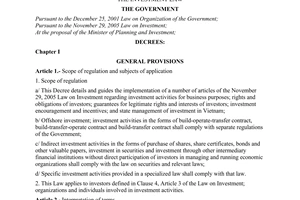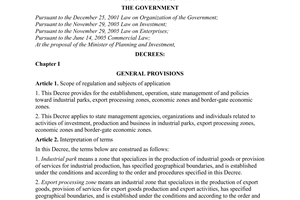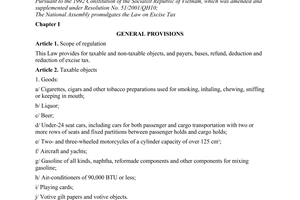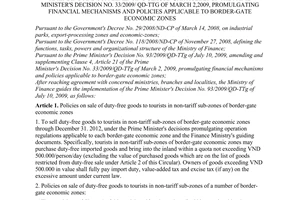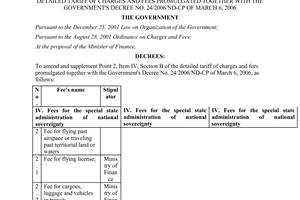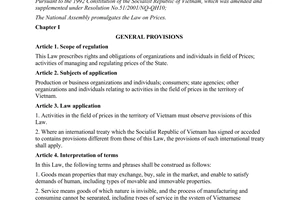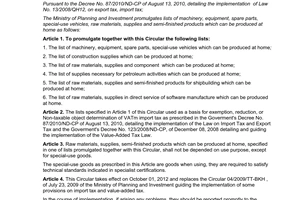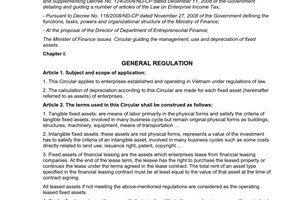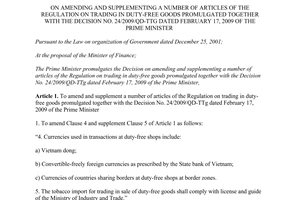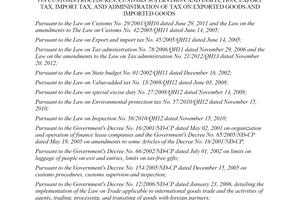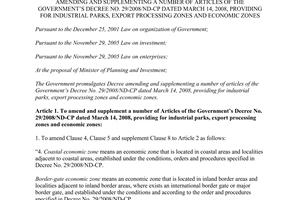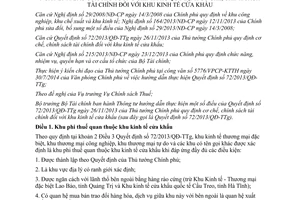Nội dung toàn văn Circular No. 109/2014/TT-BTC guiding Decision No. 72/2013/QD-TTg
|
THE MINISTRY OF
FINANCE |
THE SOCIALIST
REPUBLIC OF VIETNAM |
|
No. 109/2014/TT-BTC |
Hanoi, August 15, 2014 |
CIRCULAR
GUIDING A NUMBER OF ARTICLES OF THE PRIME MINISTER’S DECISION NO. 72/2013/QD-TTG OF NOVEMBER 26, 2013, ON FINANCIAL MECHANISMS AND POLICIES APPLICABLE TO BORDER-GATE ECONOMIC ZONES
Pursuant to the Government’s Decree No. 29/2008/ND-CP of March 14, 2008, on industrial parks, export processing zones and economic zones; and Decree No. 164/2013/ND-CP of November 12, 2013, amending and supplementing a number of articles of Decree No. 29/2008/ND-CP of March 14, 2008;
Pursuant to the Prime Minister s Decision No. 72/2013/QD-TTg of November 26, 2013, on financial mechanisms and policies applicable to border-gate economic zones;
Pursuant to the Government’s Decree No. 215/2013/ND-CP of December 23, 2013, defining the functions, tasks, powers and organizational structure of the Ministry of Finance;
In implementation of the Prime Minister’s directing opinions in the Government Office’s Official Letter No. 5776/VPCP-KTTH of July 30,2014, guiding the implementation of Decision No. 72/2013/QD-TTg;
At the proposal of the Director of the Tax Policy Department;
The Minister of Finance promulgates the Circular guiding a number of articles of the Prime Minister’s Decision No. 72/2013/QD-TTg of November 26, 2013, on financial mechanisms and policies applicable to border-gate economic zones (below referred to as Decision No. 72/2013/QD-TTg).
Article 1. Non-tariff areas of border-gate economic zones
Under Clause 2, Article 3 of Decision No. 72/2013/QD-TTg special economic- commercial zones, industrial-commercial zones, free trade zones and zones under other names shall be determined to be non-tariff areas of border-gate economic zones of which goods and service-trading and exchange relations with the outside are regarded as import and export relations when fully satisfying the following conditions:
1. They are established under the Prime Minister’s decision.
2. They are geographical areas with identified boundaries.
3. They are separated from the outside by solid fence (excluding Lao Bao special economic- commercial zone in Quang Tri province and Cau Treo international border-gate economic zone in Ha Tinh province).
4. They have entrances and gates to ensure conditions for customs and other related professional agencies and have customs offices to inspect and supervise goods and vehicles entering and leaving the areas.
Article 2. Enterprise income tax incentives
Enterprise income tax incentives for enterprises operating in border-gate economic zones must comply with provisions applicable to economic zones in Enterprise Income Tax Law No. 14/2008/QH12, Law No. 32/2013/QH13 Amending and Supplementing a Number of Articles of the Enterprise Income Tax Law and guiding documents.
Article 3. Personal income tax incentives
Vietnamese and foreigners who directly work or carry out production and business activities in border-gate economic zones, earn incomes from their jobs or production and business activities in border-gate economic zones and are liable to personal income tax under the Personal Income Tax Law are entitled to a 50% reduction of payable tax amounts as prescribed in the Finance Ministry’s Circular No. 176/2009/TT-BTC of September 9, 2009, guiding the reduction of personal income tax for persons working in economic zones.
Article 4. Value-added tax incentives
1. Goods and services exported abroad from non-tariff areas of border-gate economic zones are not subject to value-added tax.
2. Goods and services produced and consumed in non-tariff areas of border-gate economic zones are not subject to value-added tax.
3. Goods and services traded between non-tariff areas of border-gate economic zones are not subject to value-added tax.
4. Goods and services imported from abroad into and consumed in non-tariff areas of border-gate economic zones are not subject to value-added tax, except those on the list of goods liable to tax upon importation from abroad into non-tariff areas of border-gate economic zones provided in Section II of Appendix II to this Circular.
5. Goods and services exported from functional quarters in border-gate economic zones or from Vietnam’s inland into non-tariff areas of border-gate economic zones are entitled to the 0% value-added tax rate, except the following cases:
a/ Goods and services ineligible for the 0% value-added tax rate prescribed in Clause 1, Article 8 of Value-Added Tax Law No. 13/2008/QH12 (which was amended and supplemented in Clause 3, Article 1 of Law No. 31/2013/QH13 Amending and Supplementing a Number of Articles of the Value-Added Tax Law) and guiding documents;
b/ Goods not going through customs procedures when being exported from other functional quarters in border-gate economic zones or from Vietnam’s inland into non-tariff areas which are not separated from the outside by solid fence.
The list of goods not going through customs procedures and the list of goods to be inspected prior to value-added tax refund applicable to goods and services defined in this Clause are provided in Appendix I to this Circular.
6. Goods and services introduced from non-tariff areas of border-gate economic zones for consumption in other functional quarters of border-gate economic zones or in Vietnam’s inland are subject to value-added tax as prescribed by law.
Article 5. Excise tax
1. Goods exported abroad from non-tariff areas of border-gate economic zones are not subject to excise tax.
2. Goods produced and consumed in non-tariff areas of border-gate economic zones are not subject to excise tax, except the following cases:
a/ Automobiles of under 24 seats;
b/ Goods produced and consumed within non-tariff areas of border-gate economic zones which are not separated from the outside by solid fence.
3. Goods traded among non-tariff areas of border-gate economic zones are not subject to excise tax, except the following cases:
a/ Automobiles of under 24 seats;
b/ Goods produced and consumed within non-tariff areas of border-gate economic zones which are not separated from the outside by solid fence.
4. Goods imported from abroad into and consumed in non-tariff areas of border-gate economic zones are not subject to excise tax, except the following cases:
a/ Automobiles of under 24 seats;
b/ Goods imported from abroad into non-tariff areas of border-gate economic zones which are not separated from the outside by solid fence;
c/ Goods on the list of goods liable to tax upon importation from abroad into non-tariff areas of border-gate economic zones provided in Section II of Appendix II to this Circular.
5. Goods exported from other functional quarters in border-gate economic zones or from Vietnam’s inland into non-tariff areas of border-gate economic zones are not subject to excise tax, except the following cases:
a/ Automobiles of under 24 seats;
b/ Goods exported from the inland into non-tariff areas of border-gate economic zones which are not separated from the outside by solid fence.
6. Goods from non-tariff areas of border-gate economic zones introduced into other functional quarters in border-gate economic zones or Vietnam’s inland for consumption are subject to excise tax, except those subject to excise tax under Clauses 2, 3, 4 and 5 of this Article.
7. Excise tax deduction and refund and other matters related to excise tax-liable goods and services must comply with the Excise Tax Law and its guiding documents.
Article 6. Export duty and import duty incentives
1. Goods imported for the creation of fixed assets of investment projects in border-gate economic zones (excluding non-tariff areas) are exempt from import duty, including:
a/ Equipment and machinery which fully satisfy the following conditions:
a.1/ They are suitable to investment fields, objectives and sizes of investment projects;
a.2/ They comply with provisions on fixed assets in the Finance Ministry’s Circular No. 45/2013/TT-BTC of April 25,2013, guiding the management, use and depreciation of fixed assets.
b/ Special-use vehicles in technological lines which are domestically unavailable; and vehicles for worker commutation, including automobiles of 24 seats or more and waterway craft, of which:
b.1/ Domestically manufactured special-use vehicles used as a basis for the import duty exemption prescribed at this Point must comply with the Planning and Investment Ministry’s Circular No. 04/2012/TT-BKHDT of August 13, 2012, promulgating the list of home-made machinery, equipment, spare parts, special-use vehicles, raw materials, supplies and semi-finished products;
b.2/ Special-use vehicles in technological lines used as a basis for the import duty exemption prescribed at this Point must comply with the Science and Technology Ministry’s Circular No. 01/2014/TT-BKHCN of February 18, 2014, guiding the determination of special- use vehicles in technological lines.
c/ Components, details, detached parts, spare parts, fittings, molds and accompanying accessories for synchronous assembly with equipment, machinery and special-use vehicles prescribed at Points a and b of this Clause if they are:
c.1/ Components, details and parts of equipment, machinery and vehicles imported in completely knocked down form; or
c.2/ Components, details, detached parts, spare parts, fittings, molds and accessories imported for assembly and connection of machinery and equipment to ensure their normal operation.
d/ Domestically unavailable raw materials and supplies which are used for the manufacture of equipment and machinery in technological lines or of components, details, detached parts, spare parts, fittings, molds and accompanying accessories for synchronous assembly with equipment and machinery prescribed at Point a of this Clause, of which, local raw materials and supplies used as a basis for the import duty exemption prescribed at this Point must comply with the Planning and Investment Ministry’s Circular No. 04/2012/TT-BKHDT of August 13, 2012, promulgating the list of locally made machinery, equipment, spare parts, special-use vehicles, raw materials, supplies and semi-finished products;
dd/ Domestically unavailable building raw materials of which, locally made building raw materials used as a basis for the import duty exemption prescribed at this Point must comply with the Planning and Investment Ministry’s Circular No. 04/2012/TT-BKHDT of August 13, 2012, promulgating the list of locally made machinery, equipment, spare parts, special-use vehicles, raw materials, supplies and semi-finished products.
The import duty exemption for the goods prescribed in this Clause also applies to project expansion and technology replacement or renewal.
2. Domestically unavailable raw materials, supplies and components imported for manufacture under investment projects in border-gate economic zones (other than projects manufacturing excise tax-liable products, electronic and refrigerating products and other goods as decided by the Prime Minister) are exempt from import duty for 5 (five) years from the date of manufacture.
The determination of domestically unavailable raw materials, supplies and components as a basis for import duty exemption must comply with the Planning and Investment Ministry’s Circular No. 04/2012/TT-BKHDT of August 13, 2012, promulgating the list of locally made machinery, equipment, spare parts, special-use vehicles, raw materials, supplies and semi-finished products.
3. For goods exported, imported, produced, processed, reprocessed or assembled in non-tariff areas of border-gate economic zones:
a/ Goods exported abroad from non-tariff areas of border-gate economic zones are not subject to export duty;
b/ Goods introduced from a non-tariff area to another are not subject to import and export duty;
c/ Goods imported from abroad and used only in non-tariff areas of border-gate economic zones are not subject to import duty, except those on the list of goods liable to tax upon importation from abroad into non-tariff areas of border-gate economic zones provided in Section II of Appendix II to this Circular;
d/ Goods from other functional quarters in border-gate economic zones and goods exported from Vietnam’s inland into non-tariff areas of border-gate economic zones are subject to export duty, except the following cases:
d.1/ Building raw materials which are transported (exported) from Vietnam’s inland or from other functional quarters in border-gate economic zones into non-tariff areas of border- gate economic zones for construction, repair and maintenance of general technical and social infrastructure in non-tariff areas are exempt from export duty;
d.2/ Goods and services exported from Vietnam’s inland and used only in Lao Bao special economic-commercial zone in Quang Tri province, and Cau Treo international border-gate economic zone in Ha Tinh province, are exempt from export duty;
e/ Goods introduced (imported) from non-tariff areas of border-gate economic zones into other functional quarters of border-gate economic zones or into Vietnam’s inland for consumption are subject to import duty according to current regulations, except those subject to import duty under Point c of this Clause.
g/ Goods produced, processed, reprocessed or assembled in non-tariff areas without using imported raw materials and components are exempt from import duty when imported into Vietnam’s inland; those using imported raw materials and components, when imported into Vietnam’s inland, are subject to import duty only on the quantifies of imported raw materials and components (except goods produced, processed, reprocessed or assembled under investment projects capitalized at over VND 20 billion in Ha Tinh province’s Cau Treo international border-gate economic zone and Quang Tri province’s Lao Bao special economic- commercial zone which use imported raw materials and components which are exempt from import duty for five years from the date of commencement of production when being imported into Vietnam’s inland). The payable import duty on imported raw materials and components constituting goods imported into Vietnam’s inland shall be determined as follows:
g.1/ If production and business organizations or individuals in non-tariff areas that import goods into the inland have registered with customs offices the lists of goods to be imported for use as raw materials or components for the production of goods to be imported into the inland and the norms of raw materials and components used for the production of imports before importing them into Vietnam’s inland, the payable import duty shall be determined on the basis of quantities and tax rates of goods items imported into Vietnam’s inland and the taxed value calculated based on the quantities of imported raw materials and components which constitute the goods imported into Vietnam’s inland;
g.2/ If the taxed value cannot be determined under Point g. 1 of this Clause, customs offices shall assess tax on the quantities of raw materials and components constituting the goods items imported into Vietnam’s inland in accordance with the laws on tax administration and customs valuation.
i/ Goods produced, processed, reprocessed or assembled in non-tariff areas in border-gate economic zones, which are eligible for preferential or special preferential import duty rates, are entitled to such import duty rates under the law on import duty and export duty;
k/ Customs procedures and tax administration for goods exported and imported into nontariff areas of border-gate economic zones must comply with the Finance Ministry’s Circular No. 128/2013/TT-BTC of September 10, 2013, on customs procedures; customs inspection and supervision; import duty, export duty and tax administration for imports and exports (below referred to as Circular No. 128/2013/TT-BTC).
Article 7. Land and water surface rental and land use levy incentives
Investment projects in border-gate economic zones are entitled to exemption from and reduction of land and water surface rental and land use levy under Articles 13 and 14 of Decision No. 72/2013/QD-TTg of which the list of sectors eligible for special investment promotion or incentives and sectors eligible for investment promotion or incentives must comply with the Government’s Decree No. 108/2006/ND-CP of September 22, 2006, detailing and guiding a number of articles of the Investment Law.
Article 8. Collection of charges and fees
1. Border-gate economic zone management boards shall collect, remit, manage and use charges and fees for charged jobs and services which they are authorized to provide according to documents issued by competent agencies applicable to each type of charge or fee.
2. Jobs and services provided under authorization with charges and fees on the detailed list of charges and fees promulgated together with the Government’s Decree No. 24/2006/ND-CP of March 6, 2006, amending and supplementing a number of articles of Decree No. 57/2002/ ND-CP of June 3, 2002, detailing the implementation of the Ordinance on Charges and Fees, and Decree No. 115/2011/ND-CP of December 14, 2011, amending and supplementing Point 2, Section IV, Part B of the detailed lists of charges and fees promulgated together with Decree No. 24/2006/ND-CP for which guiding documents are not available or guiding documents no longer suit actual conditions in border-gate economic zones, border-gate economic zone management boards shall make collection plans (covering charge and fee rates and management and use of collected charges and fees as guided in the Finance Ministry’s Circular No. 63/2002/ TT-BTC of July 24,2002, and Circular No. 45/2006/TT-BTC of May 25, 2006, amending and supplementing Circular No. 63/2002/TT-BTC of July 24, 2002, guiding the implementation of the law on charges and fees) and submit them to competent agencies for consideration, promulgation and implementation.
Article 9. Infrastructure use levy
1. Infrastructure use levy means a revenue collected to offset costs of construction, repair, maintenance, service condition assurance or restoration of technical and social infrastructure facilities.
2. Investors having production and business projects in border-gate economic zones that use technical and social infrastructure facilities of these zones shall pay infrastructure use levy.
3. For facilities built by operators of socio-technical infrastructure of border-gate economic zones:
a/ Operators of socio-technical infrastructure of border-gate economic zones may manage and operate such infrastructure and collect infrastructure use levy from investors in border- gate economic zones;
b/ Operators of socio-technical infrastructure of border-gate economic zones built with their investment may decide on rates of socio-technical infrastructure use levy which shall be calculated based on the percentage of one of the following figures:
b.1/ Total export revenue.
b.2/ Total revenue from production and services.
b.3/ Total rental of land with infrastructure.
4. For facilities not built by operators of socio-technical infrastructure of border-gate economic zones:
a/ Border-gate economic zone management boards shall organize the management, operation, repair and maintenance of such infrastructure and collect infrastructure use levy from investors in the zones for repair and maintenance activities to ensure service conditions of these infrastructure facilities and for their management in accordance with law;
b/ Provincial-level People’s Committees shall set use levy rates of common socio- technical infrastructure not built by operators of socio-technical infrastructure in accordance with the Price Law and other relevant laws. Provincial-level People’s Committees shall decide on pricing methods in conformity with local socio-economic situations and policies of the State.
5. Operators of socio-technical infrastructure of border-gate economic zones and border- gate economic zone management boards may manage and use all collected charges to offset expenses according to Clauses 1, 3 and 4 of this Article and pay taxes in accordance with law. When collecting socio-technical infrastructure use levy, operators of socio-technical infrastructure and border-gate economic zone management boards shall issue receipts to payers; and separately account, manage and use all collected amounts in accordance with law. Infrastructure land use levy receipts issued by operators of socio-technical infrastructure and border-gate economic zone management boards to payers are valid documents which may be used for accounting infrastructure land use levy as production and business expense and for value-added tax credit upon determination of tax obligations as prescribed by law.
Article 10. Charges for use of infrastructure facilities (for vehicles entering and leaving border gates) and other public utility works and services in border-gate economic zones
1. Charges for use of infrastructure facilities (for vehicles entering and leaving border gates) and other public utility works and services in border-gate economic zones are revenues collected to offset expenses for repair, maintenance and assurance of service conditions or renovation of those facilities, works and services.
2. Organizations and persons having vehicles entering and leaving border gates shall pay charges for use of infrastructure facilities (for vehicles entering and leaving border gates); organizations and persons using other public utility works and services in border-gate economic zones (other than investors of production and business investment projects in border-gate economic zones paying infrastructure use levy according to Article 9 of this Circular) shall pay charges for use of public utility works and services.
3. Operators of socio-technical infrastructure of border-gate economic zone shall organize the collection of charges for use of infrastructure facilities (for vehicles entering and leaving border gates) and other public utility works and services in border-gate economic zones. For border-gate economic zones having no operators of socio-technical infrastructure, pursuant to Article 4 of the Government’s Decree No. 57/2002/ND-CP of June 3,2002, detailing the Ordinance on Charges and Fees, provincial-level People’s Committees of localities having these border-gate economic zones shall propose provincial-level People’s Councils to authorize other organizations to collect charges until there are operators of socio-technical infrastructure of border-gate economic zones.
4. Rates of charges for use of infrastructure facilities (for vehicles entering and leaving border gates) and other public utility works and services in border-gate economic zones: Based on local practical conditions and capacity of offsetting expenses for repair, maintenance and assurance of service conditions or renovation of infrastructure facilities, provincial-level People’s Committees shall propose provincial-level People’s Councils to set specific charge rates appropriately in adherence to the principle of charge rate determination prescribed in Article 8 of the Government’s Decree No. 57/2002/ND-CP of June 3, 2002, detailing the Ordinance on Charges and Fees and its guiding documents.
5. Management and use of collected charges:
a/ Charges collected from state-invested facilities and utilities are state budget revenues. Charge-collecting organizations that have received state budget funds for their charge collection according to annual budget estimates shall remit all collected charges into the state budget. Charge-collecting organizations that receive no state budget funds for their charge collection or are authorized to collect charges outside their regular functions and tasks may keep part of collected charge amounts to cover charge collection expenses in accordance with the Ordinance on Charges and Fees and its guiding documents. The remaining charge amounts shall be remitted into the state budget;
b/ Charges collected from facilities and utilities not invested by the State are not state budget revenues. Collected charges are revenues of charge-collecting organizations, which shall pay taxes based on charge collection results according to current regulations of the State.
6. Provincial-level People’s Councils of localities having border-gate economic zones shall decide on specific rates and the management and use of charges for use of infrastructure facilities (for vehicles entering and leaving border gates) and other public utility works and services in border-gate economic zones proposed by provincial-level People’s Committees in accordance with this Article and the law on charges and fees.
7. Other matters related to charge collection, scope and subjects of application of charges, adjustment of charge rates, collection, remittance, management and use of collected chares, charge collection documents, and publicity of the charge collection regime not prescribed in this Article must comply with the Finance Ministry’s Circular No. 02/2014/TT-BTC of January 2, 2014, guiding charges and fees to be set by provincial-level People’s Councils; Circular No. 63/2002/TT-BTC of July 24, 2002, guiding the law on charges and fees; Circular No. 45/2006/ TT-BTC of May 25,2006, amending and supplementing Circular No. 63/2002/TT-BTC of July 24,2002; Circular No. 153/2012/TT-BTC of September 17,2012, guiding the printing, issuance, management and use of documents on collection of charges and fees of the state budget; and Circular No. 156/2013/TT-BTC of November 6, 2013, guiding a number of articles of the Tax Administration Law; the Law Amending and Supplementing a Number of Articles of the Tax Administration Law and the Government’s Decree No. 83/2013/ND-CP of July 22, 2013.
Article 11. Sale of duty-free goods to tourists in non-tariff areas of border-gate economic zones
1. Duty-free goods shall be sold to tourists in each non-tariff area of a border-gate economic zone under the Prime Minister’s decision on the operation regulation applicable to such border-gate economic zone. Tourists in non-tariff areas of border-gate economic zones may buy and bring into the inland duty-free imports worth no more than VND 1,000,000 (one million)/person/day. When the value of goods exceeds VND 1,000,000/person/day, tourists shall carry out customs procedures, declare and pay import duty and value-added tax for the excessive value under Circular No. 128/2013/TT-BTC.
2. The list of dutiable goods on sale to tourists in non-tariff areas and the list of goods liable to tax upon importation from abroad into non-tariff areas of border-gate economic zones (including import duty, excise tax (if any) and value-added tax) are provided in Appendix II to this Circular.
3. Provincial-level People’s Committees of localities having border-gate economic zones shall:
a/ Prescribe conditions (investment capital level and land area used for sale of duty-free goods) and direct and manage the sale of duty-free goods to tourists in non-tariff areas in conformity with local practical conditions and tourism development requirements and concurrently ensure tight management to prevent smuggling and trade frauds;
b/ Referring to the Regulation on trading in duty-free goods promulgated together with the Prime Minister’s Decision No. 24/2009/QD-TTg of February 17, 2009; Decision No. 44/2013/QD-TTg of July 19, 2013, amending and supplementing a number of articles of the Regulation on trading in duty-free goods promulgated together with the Prime Minister’s Decision No. 24/2009/QD-TTg and guiding documents, provincial-level People’s Committees of localities having border- gate economic zones shall formulate and issue regulations on purchase and sale of duty-free goods in non-tariff areas of border-gate economic zones in their localities. A regulation must ensure:
b.1/ Clear determination of tourists eligible to the policy on purchase of duty-free goods.
b.2/ Purchase and sale of duty-free goods by proper subjects within the prescribed limit.
c/ Work out and coordinate with functional forces in taking measures to prevent and handle illegal trading, smuggling and tax evasion; direct local functional agencies (border- gate economic zone management boards, public security, border guard, market control, tax, customs and finance) in increasing coordination in taking inspection and control measures to fight smuggling and trade frauds in border-gate economic zones.
Article 12. Organization of implementation
1. Responsibilities of customs offices:
a/ Customs offices shall arrange goods inspection forces, facilities and equipment meeting the requirements of inspection, supervision and control of goods and vehicles entering and leaving non-tariff areas of border-gate economic zones to ensure prevention and control of smuggling and illegal transportation of goods across the border, and conduct physical inspection of all imports and exports eligible for tax incentives as prescribed in Decision No. 72/2013/QD-TTg and this Circular in localities under their management;
b/ The General Department of Customs shall guide provincial-level Customs Departments in annually conducting post-customs clearance inspection of enterprises with high sales from goods entitled to high tax incentives and at high risk for the purpose of risk management, report inspection results to the General Department of Customs for further reporting to the Ministry of Finance before March 30 of the subsequent year;
c/ To organize the implementation of the laws on taxes and customs for imports and exports, including goods purchased at shops and markets in non-tariff areas introduced into the inland in accordance with Circular No. 128/2013/TT-BTC;
d/ To increase coordination with related functional agencies in preventing and handling fraudulent acts and abuse of incentive policies for illegal trading.
2. Responsibilities of tax agencies:
a/ For goods and services from other functional quarters in border-gate economic zones or from the inland exported into non-tariff areas of border-gate economic zones entitled to the 0% value-added tax rate, tax agencies managing selling enterprises shall conduct pre-tax refund inspection as follows:
a.1/ To classify value-added tax refund dossiers related to the above goods and services subject to inspection prior to tax refund.
a.2/ To check value-added tax credit and refund conditions for exports (export contracts, export declarations, via-bank payment documents, sale invoices) under regulations.
a.3/ To coordinate with tax agencies directly managing border-gate economic zones in inspecting buyers in non-tariff areas of border-gate economic zones (address, tax identification number, operation status, etc.), specifically:
- Selling enterprises may have value-added tax refunded only for goods and services sold to buying enterprises which are headquartered in non-tariff areas of border-gate economic zones and currently operating.
- Selling enterprises may have value-added tax refunded only for goods and services sold into non-tariff areas of border-gate economic zones when those goods and services have been consumed by buying enterprises (such as building raw materials already used for work construction, etc.) in non-tariff areas of border-gate economic zones or when buying enterprises have declared value- added tax for purchased goods or services to tax agencies managing border-gate economic zones.
a.4/ In addition to the above tax refund inspection contents, tax agencies shall:
- Check other arising economic operations and related documents and records, including purchase, sale, warehousing and inventory of goods; transportation, loading and trading costs; economic-technical norms of production and construction activities, etc.
- Verify and compare input invoices and sale invoices.
b/ When the goods prescribed at Point a above are further sold from non-tariff areas of border-gate economic zones into other functional quarters of border-gate economic zones or into the inland, they must have customs procedures cleared and value-added tax paid like other imports.
- Check other arising economic operations and related documents and records, including purchase, sale, warehousing and inventory of goods; transportation, loading and trading costs; economic-technical norms of production and construction activities, etc.
- Verify and compare input invoices and sale invoices; verify head offices, business addresses, tax identification numbers and operation status of buyers in non-tariff areas.
c/ Quarterly report to the Ministry of Finance on the value-added tax refund according to the prescribed refund process, with the general report on detailed tax refund results added with a line reporting on the input value-added tax refund for goods exported into border-gate economic zones.
3. Responsibilities of traders of duty-free goods in non-tariff areas of border-gate economic zones:
a/ Traders may sell duty-free goods to tourists in non-tariff areas only when they have shops included in the approved detailed construction planning on functional quarters and possess duty-free goods trading licenses issued by a competent agency according to regulations of provincial-level People’s Committees;
b/ To sell duty-free goods strictly according to the Regulation on purchase and sale of duty-free goods promulgated by the provincial-level People’s Committee and the guidance in Circular No. 128/2013/TT-BTC;
c/ Duty-free goods traders and businesses purchasing and selling goods eligible for tax exemption shall operate computer systems connected with networks of tax agencies and customs offices for administrative procedure reform and for management of duty-free goods trading activities under regulations;
d/ To monthly report on imports and exports in the month and warehousing, ex-warehousing and inventory to customs offices managing non-tariff areas for examination, monitoring and management under the guidance in Circular No. 128/2013/TT-BTC.
Article 13. Effect
1. This Circular takes effect on October 1,2014.
2. This Circular annuls:
a/ The Finance Ministry’s Circular No. 137/2009/TT-BTC of July 3, 2009, guiding a number of articles of the Prime Minister’s Decision No. 33/2009/QD-TTg of March 2, 2009, promulgating financial mechanisms and policies applicable to border-gate economic zones;
b/ The Finance Ministry’s Circular No. 08/2010/TT-BTC of January 14, 2010, guiding the Prime Minister’s Decision No. 93/2009/QD-TTg of July 10, 2009, amending and supplementing Clause 4, Article 21 of Decision No. 33/2009/QD-TTg of March 2, 2009, promulgating financial mechanisms and policies applicable to border-gate economic zones;
c/ The Finance Ministry’s Circular No. 116/2010/TT-BTC of August 4, 2010, amending and supplementing the Finance Ministry’s Circular No. 137/2009/TT-BTC of July 3, 2009, guiding a number of articles of the Prime Minister’s Decision No. 33/2009/QD-TTg of March 2, 2009, promulgating financial mechanisms and policies applicable to border-gate economic zones.
3. Financial policies not mentioned in this Circular must comply with current guiding documents applicable to each field.
4. When legal documents referred to in this Circular are amended, supplemented or replaced, the provisions of the amending, supplementing or replacing documents shall apply.
5. Investment projects which were granted investment licenses or investment certificates before the effective date of Decision No. 72/2013/QD-TTg and currently enjoy incentives higher than those prescribed in Decision No. 72/2013/QD-TTg may continue enjoying the incentives stated in their investment licenses or investment certificates for the remaining duration, if they fully satisfy the following conditions for incentives:
a/ The investment licenses or certificates are valid and have no change in investment incentive contents;
b/ The level of incentives stated in the investment licenses or certificates is conformable with law at the time of grant of such licenses or certificates.
6. Investment projects which were granted investment licenses or investment certificates before the effective date of Decision No. 72/2013/QD-TTg and the incentives stated in their investment licenses or investment certificates are lower than those prescribed in Decision No. 72/2013/QD-TTg are entitled to the incentives prescribed in Decision No. 72/2013/QD-TTg for the remaining duration of the projects.
7. Investment projects obtaining investment licenses or investment certificates before the effective date of Decision No. 72/2013/QD-TTg that produce, process, reprocess or assemble goods in non-tariff areas using raw materials, supplies, accessories or semi-products imported from abroad are liable to import duty on those raw materials, supplies, accessories or semi-products; enterprises having these investment projects may choose to determine payable import duty amounts for the raw materials, supplies, accessories or semi-products constituting the goods imported into Vietnam’s inland for the remaining duration of their projects in either of the following ways and shall send a written request for selection of import duty determination method to customs offices managing non-tariff areas:
a/ To continue implementing Clause 4, Article 13 of Decision No. 33/2009/QD-TTg as follows:
a.1/ To determine payable import duty amounts based on the quantity, tax rates and taxed prices of raw materials, supplies, accessories or semi-products imported from abroad constituting goods in case importers have re-registered with customs offices lists of imports used as raw materials, supplies, accessories and semi-products for production of goods imported into the inland and norms of raw materials, supplies, accessories and semi-products used for production of imports before being imported into Vietnam’s inland.
a.2/ When import duty amounts cannot be determined as prescribed at Point a.1 of this Clause, import duty shall be calculated based on tax rates and taxed prices of goods produced, processed, reprocessed or assembled and imported into Vietnam’s inland at the time of opening customs declarations.
b/ To implement Clause 6, Article 12 of Decision No. 72/2013/QD-TTg as follows:
b.1/ To determine payable import duty amounts based on the quantity and tax rates of goods imported into the inland and taxed value of the raw materials or accessories imported from abroad constituting goods imported into Vietnam’s inland.
b.2/ When import duty amounts cannot be determined as prescribed at Point b.1 of this Clause, customs offices shall assess tax for the raw materials or accessories imported from abroad constituting goods imported into Vietnam’s inland in accordance with the laws on tax administration and customs valuation.
8. Any problems arising in the course of implementation should be promptly reported to the Ministry of Finance for relevant revision.-
|
|
FOR THE
MINISTER OF FINANCE |
APPENDIX I
LIST OF GOODS NOT GOING THROUGH CUSTOMS PROCEDURES
AND LIST OF GOODS SUBJECT TO INSPECTION PRIOR TO VALUE-ADDED TAX REFUND
(To the Finance Ministry’s Circular No. 109/2014/TT-BTC of August 15, 2014)
I. List of goods not going through customs procedures when exported from other functional quarters in border-gate economic zones and from Vietnam’s inland into non-tariff areas which are not separated from the outside by solid fence (not entitled to the 0% value-added tax rate)
1. Beer.
2. Beverages, liquor and alcoholic drinks.
3. Cigarette, cigar.
4. Cell phones and cell-phone pre-paid cards.
5. Automobiles.
6. Petrol, oil, gas.
7. Stationery (printing paper of all kinds, writing paper, notebooks and pens of all kinds, rulers, chalks, pins, clips, cellophane, tracing paper, plastic bags, plastic briefcases, scotch tape, glue, envelops, cardboard bags, document holders, staplers and hole punches).
8. Edible oil of all kinds.
9. Sugar.
10. Milk of all kinds, baby food.
11. Instant noodles, vermicelli, gruel and rice noodle.
12. Confectionery of all kinds.
13. Soap, detergent, shampoo, shower lotions and toothpaste.
14. Gas used for cooling equipment.
15. Powder coffee of all kinds, monosodium glutamate, food seasoning, swallow’s nest, diapers, clothes, footwear, saw blade.
16. Computer accessories and parts, electronic printed circuit boards.
17. Tablets, laptops.
II. List of goods subject to inspection prior to value-added tax refund for goods exported from other functional quarters in border-gate economic zones and Vietnam’s inland into non-tariff areas
1. For export into non-tariff areas which are not separated from the outside by solid fence
All goods except electricity and clean water.
2. For export into non-tariff areas which are separated from the outside by solid fence
a/ Construction sand; b/ Stone, gravel; c/ Terracotta bricks; d/ Cement; dd/ Construction iron and steel.
APPENDIX II
LIST OF GOODS INELIGIBLE FOR DUTY-FREE SALE TO
TOURISTS AND LIST OF GOODS LIABLE TO TAX UPON IMPORTATION FROM ABROAD INTO
NONTARIFF AREAS OF BORDER-GATE ECONOMIC ZONES
(To the Finance Ministry’s Circular No. 109/2014/TT-BTC of August 15, 2014)
I. List of goods ineligible for duty-free sale to tourists in non-tariff areas
1. Cigarette, cigar and other tobacco-based products used for smoking, sniffing, chewing, snuffing or sucking; unprocessed tobacco; waste tobacco.
2. Liquor.
3. Beer.
4. Automobiles of under 24 seats, including those for carrying both passengers and cargo with two or more seat lines and fixed separators between passenger and cargo compartments.
5. Motorbikes, three-wheel motorcycles with cylinder capacity of over 125cm3.
6. Aircraft, yachts.
7. Petrol of all kinds, naphtha, reformade component and other materials for petrol preparation.
8. Air conditioners of up to 90,000 BTU.
9. Playing cards.
10. Votive papers.
11. Fresh, preserved or cooked bird and poultry eggs.
12. Cane or beet sugar and chemically pure sucroza sugar in solid state.
13. Salt (including edible salt and denatured salt) and pure sodium chloride in liquid state or not, or containing agents preventing hardening or increasing melting; salt water.
II. List of goods liable to tax upon importation from abroad into non-tariff areas of border-gate economic zones
1. Goods liable to tax upon importation from abroad into non-tariff areas of border-gate economic zones are those imported from abroad into non-tariff areas, other than goods imported for investment project implementation which include:
a/ Goods imported for creation of fixed assets of investment projects in non-tariff areas of border-gate economic zones;
b/ Raw materials, supplies, accessories and semi-products imported for production under investment projects in non-tariff areas of border-gate economic zones.
2. The identification of goods imported for investment project implementation must comply with the guidance on goods exported and imported for investment projects in Circular No. 128/2013/TT-BTC.-





